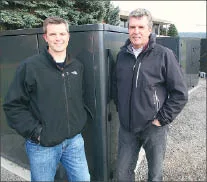
Home » Demand Energy makes its move
Demand Energy makes its move
Power-storage company pursues 'queen on chessboard'

November 3, 2011
Three years after its inception, Liberty Lake-based Demand Energy Networks Inc. has brought its energy-storage technology to market and is expecting exponential growth in coming months.
Led by a veteran team of Spokane-area entrepreneurs and corporate executives with backgrounds in the utility, telecommunications, and manufacturing industries, the company began making deliveries on its first handful of energy-storage units earlier this fall.
With customer commitments from China to New York City, the company believes it is closer to figuring out "the queen on the chessboard," says David Curry, the former World Wide Packets Inc. CEO who now is president and CEO of Demand Energy.
"In the power industry, the idea of being able to store energy is the queen on the chessboard," Curry says. "If you could figure out how to do that, you've really got something."
The company delivered three of its energy-storage units, called Demand Shifters, in the third quarter of this year and had more being installed this week. Brett Turner, Demand Energy CFO who co-founded the business with Curry, says the company expects to deliver at least 12 units this quarter.
"The trajectory will be significantly going up from there," Turner says.
Located in an 8,000-square-foot space in the giant Meadowwood Technology Campus, which is the former Agilent Technologies Inc. complex in Liberty Lake, Demand Energy has 12 full-time employees and a mix of eight part-time workers and independent contractors who are involved in the company's day-to-day operations.
The company declines to disclose revenue and employment projections, other than to say it expects them to grow exponentially in both sales and employees in the coming months and through 2012.
In simplest terms, Demand Energy's Demand Shifter stores energy during periods of low usage and distributes it during peak usage. Typically located onsite for an end user, the technology stores energy using lithium-ion batteries—similar in design to, though far larger than, batteries used in mobile phones and other electronics.
In addition to its use on the conventional power grid, a Demand Shifter can be linked to a solar-energy or wind-energy system, allowing an owner to store energy when the sun is shining or the wind is blowing, then provide power when it's dark or still. Such a system typically is connected to the grid so that excess energy can be sold back to the power company as well.
With the help of a $250,000 grant from Innovate Washington—the organization into which SIRTI was absorbed—Demand Energy recently installed a 30-kilowatt system with 120 kilowatt hours of energy storage, which equates to roughly four hours' worth of power, at the Meadowwood Technology Campus. Three six-foot cube Demand Shifter units are situated about 10 yards from Demand Energy's front door.
Wayne Frost, the managing director of Greenstone Commercial, which is developing the Meadowwood campus, says in a press release the company expects to save on energy costs as a result of its ability to store power that its solar-energy system generates. Also, he says, the company expects the technology to be a feature that's attractive to prospective tenants.
Turner confirms that Demand Energy technology is expected to reduce energy costs for end users, but the company doesn't know at this stage how much those costs will fall.
The company has had other opportunities close to home. It installed its first two prototype units at facilities operated by Avista Corp. and Inland Power & Light Co., and it's talking with utilities on the state's West Side as well. In general, Turner says, Demand Energy expects about three-quarters of its business to come from utilities and about one-quarter of it to come from building or development owners.
NYC to China
While opportunity exists in the Northwest, Curry and Turner say much of the company's potential lies far from home.
In late October, Curry says, the company was installing two of its units at high-rise apartment buildings in Manhattan. Turner says the New York City market is one of the primary areas of focus for the company because of the intense demand on the energy grid there.
Curry says, however, the company's most immediate, large-scale opportunities for growth lie in China. He says the company is in the final stages of finalizing a joint venture with China-based lithium-ion battery manufacturer Tianjin Lishen Battery Joint-Stock Co. Ltd., whose batteries are commonly found in laptop computers and mobile devices, to sell Demand Energy technology in that country.
"We have developed a significant pipeline of business in China, we'll see the results of that in 2012," Curry says.
Turner says the company currently is working on what he calls a growth round of venture capital and speaking with interested investors. He asserts that Demand Energy's technology has a profit-margin potential that the company is excited about. It's possible, he says, the company could be operating in the black at some point in 2013.
Curry says, however, that the company's primary goal in these formative years to grow its operations.
"The issue isn't to achieve profitability right now," he says. "The issue is to secure capital to achieve growth. We'll be reinvesting back into the business."
Part of that investment involves improving its own technology. For example, although the company's technology typically relies on lithium-ion batteries to store energy, it's developing a proprietary lead-acid battery that Curry says is expected to be lower weight and use less lead than similar batteries currently on the market. Most importantly, he says, the battery is being designed to last 10 years, which would be triple or quadruple the lifespan of other batteries. The company hopes to start using that battery in its units during the first half of 2012.
Curry and Turner founded Demand Energy after the previous company they led together, Spokane Valley-based telecommunications networking products maker World Wide Packets Inc., was sold and became part of Baltimore area-based Ciena Corp.
Early on, three former executives from Liberty Lake-based automatic-meter-reading technology maker Itron Inc., Doug Staker and Rob and Randi Neilson, joined Curry and Turner as investors in the young startup. They were fortunate, Curry says, in that they all were able to finance the early months independently and work for eight or nine months without drawing salaries. All five of them remain involved in the company, he says.
Curry says this is the fourth startup in which he has been involved in the past 30 years, and he asserts Demand Energy is benefiting from the depth of knowledge its executives have in the telecommunications, utility, and manufacturing fields.
"The convergence of experience gives us a unique DNA with which to grow this business," he says.
Latest News
Related Articles




